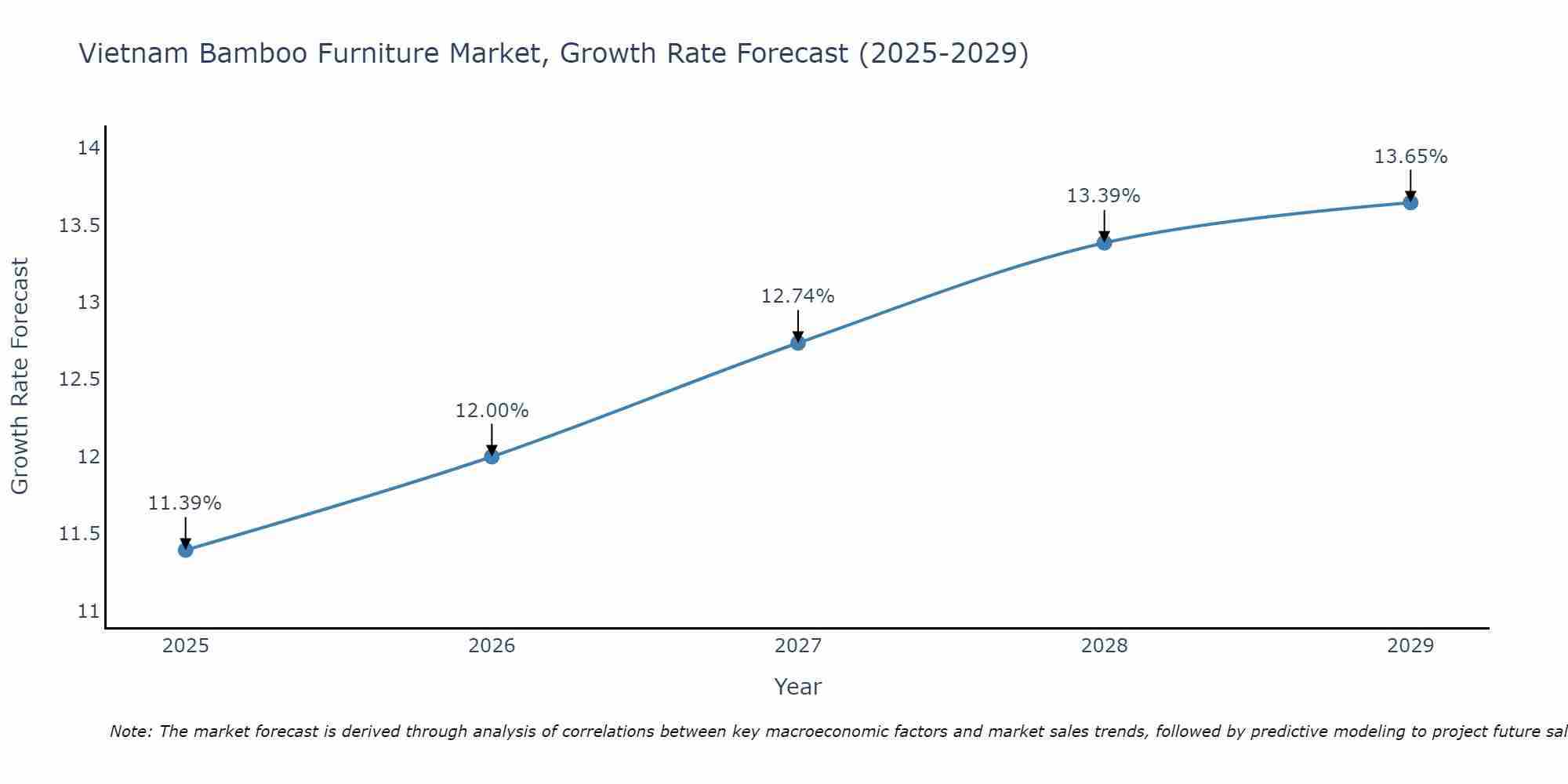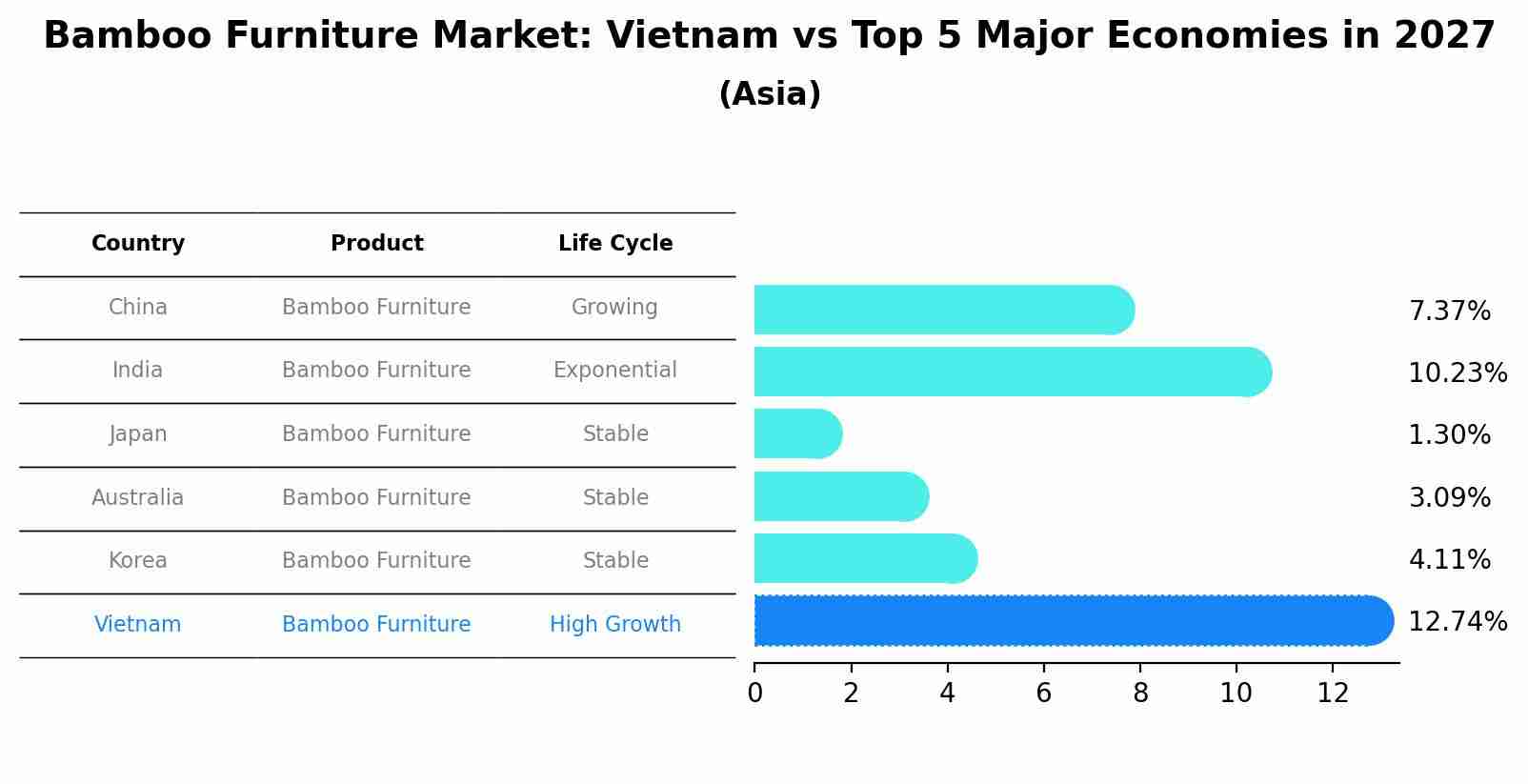Vietnam Bamboo Furniture Market (2025-2031) Outlook | Industry, Share, Companies, Size, Growth, Value, Revenue, Analysis, Trends & Forecast
| Product Code: ETC370890 | Publication Date: Aug 2022 | Updated Date: Apr 2025 | Product Type: Market Research Report | |
| Publisher: 6Wresearch | No. of Pages: 75 | No. of Figures: 35 | No. of Tables: 20 | |
Vietnam Bamboo Furniture Market Size Growth Rate
The Vietnam Bamboo Furniture Market is poised for steady growth rate improvements from 2025 to 2029. Commencing at 11.39% in 2025, growth builds up to 13.65% by 2029.

Bamboo Furniture Market: Vietnam vs Top 5 Major Economies in 2027 (Asia)
By 2027, the Bamboo Furniture market in Vietnam is anticipated to reach a growth rate of 12.74%, as part of an increasingly competitive Asia region, where China remains at the forefront, supported by India, Japan, Australia and South Korea, driving innovations and market adoption across sectors.

Vietnam Bamboo Furniture Market Synopsis
Bamboo furniture holds a unique position in the Vietnam furniture market, blending traditional craftsmanship with eco-friendly materials. Vietnamese consumers are increasingly embracing sustainable and natural furniture options, and bamboo furniture aligns perfectly with this trend. Bamboo`s durability, versatility, and appealing aesthetic have contributed to the growth of this market. Local artisans and manufacturers are at the forefront of producing high-quality bamboo furniture, attracting both domestic and international buyers looking for eco-conscious and aesthetically pleasing options.
Drivers of the Market
The Vietnam bamboo furniture market is on the rise as sustainability and eco-friendliness become significant considerations for consumers. Bamboo is a renewable and environmentally friendly material, making it a preferred choice for furniture production. Consumer awareness of sustainable living and eco-conscious choices is driving the demand for bamboo furniture in Vietnam. Moreover, the country`s rich tradition of bamboo craftsmanship and design is contributing to the growth of this market. Government initiatives and policies promoting the use of sustainable materials are further propelling the bamboo furniture industry forward.
Challenges of the Market
The Vietnam bamboo furniture market confronts various obstacles. One key challenge is the sustainability of bamboo sourcing, as over-harvesting can harm the environment and disrupt the supply chain. Maintaining consistent quality standards for bamboo products can also be challenging due to natural variations in bamboo, which can affect product durability. Furthermore, competition from other materials like wood and metal poses a threat to the market`s growth. Lastly, educating consumers about the benefits of bamboo furniture in terms of sustainability and durability remains an ongoing challenge.
COVID-19 Impact on the Market
The Vietnam bamboo furniture market experienced mixed effects during the pandemic. While there was a surge in demand for home office furniture due to remote working trends, the market also faced challenges. Lockdowns and economic uncertainty led to reduced consumer spending on non-essential items, including furniture. Moreover, disruptions in the supply chain affected the production of bamboo furniture. Manufacturers had to adapt by focusing on online sales and diversifying product offerings to cater to changing consumer preferences.
Key Players in the Market
In the bamboo furniture market, VIFONEX and Hoangwood Furniture are notable players. VIFONEX is recognized for its sustainable bamboo furniture designs that cater to eco-conscious consumers in Vietnam. Hoangwood Furniture offers a wide range of bamboo furniture products, blending traditional craftsmanship with modern aesthetics, contributing to the popularity of bamboo furniture in the country.
Key Highlights of the Report:
- Vietnam Bamboo Furniture Market Outlook
- Market Size of Vietnam Bamboo Furniture Market, 2024
- Forecast of Vietnam Bamboo Furniture Market, 2031
- Historical Data and Forecast of Vietnam Bamboo Furniture Revenues & Volume for the Period 2021-2031
- Vietnam Bamboo Furniture Market Trend Evolution
- Vietnam Bamboo Furniture Market Drivers and Challenges
- Vietnam Bamboo Furniture Price Trends
- Vietnam Bamboo Furniture Porter's Five Forces
- Vietnam Bamboo Furniture Industry Life Cycle
- Historical Data and Forecast of Vietnam Bamboo Furniture Market Revenues & Volume By Type for the Period 2021-2031
- Historical Data and Forecast of Vietnam Bamboo Furniture Market Revenues & Volume By Chairs & Tables for the Period 2021-2031
- Historical Data and Forecast of Vietnam Bamboo Furniture Market Revenues & Volume By Stools for the Period 2021-2031
- Historical Data and Forecast of Vietnam Bamboo Furniture Market Revenues & Volume By Beds for the Period 2021-2031
- Historical Data and Forecast of Vietnam Bamboo Furniture Market Revenues & Volume By Others for the Period 2021-2031
- Historical Data and Forecast of Vietnam Bamboo Furniture Market Revenues & Volume By End User for the Period 2021-2031
- Historical Data and Forecast of Vietnam Bamboo Furniture Market Revenues & Volume By Residential for the Period 2021-2031
- Historical Data and Forecast of Vietnam Bamboo Furniture Market Revenues & Volume By Commercial for the Period 2021-2031
- Vietnam Bamboo Furniture Import Export Trade Statistics
- Market Opportunity Assessment By Type
- Market Opportunity Assessment By End User
- Vietnam Bamboo Furniture Top Companies Market Share
- Vietnam Bamboo Furniture Competitive Benchmarking By Technical and Operational Parameters
- Vietnam Bamboo Furniture Company Profiles
- Vietnam Bamboo Furniture Key Strategic Recommendations
Frequently Asked Questions About the Market Study (FAQs):
- Single User License$ 1,995
- Department License$ 2,400
- Site License$ 3,120
- Global License$ 3,795
Search
Related Reports
- ASEAN and Thailand Brain Health Supplements Market (2025-2031) | Strategy, Consumer Insights, Analysis, Investment Trends, Opportunities, Growth, Size, Share, Industry, Revenue, Segments, Value, Segmentation, Supply, Forecast, Restraints, Outlook, Competition, Drivers, Trends, Demand, Pricing Analysis, Competitive, Strategic Insights, Companies, Challenges
- ASEAN Bearings Market (2025-2031) | Strategy, Consumer Insights, Analysis, Investment Trends, Opportunities, Growth, Size, Share, Industry, Revenue, Segments, Value, Segmentation, Supply, Forecast, Restraints, Outlook, Competition, Drivers, Trends, Demand, Pricing Analysis, Competitive, Strategic Insights, Companies, Challenges
- Europe Flooring Market (2025-2031) | Outlook, Share, Industry, Trends, Forecast, Companies, Revenue, Size, Analysis, Growth & Value
- Saudi Arabia Manlift Market (2025-2031) | Outlook, Size, Growth, Trends, Companies, Industry, Revenue, Value, Share, Forecast & Analysis
- Uganda Excavator, Crane, and Wheel Loaders Market (2025-2031) | Strategy, Consumer Insights, Analysis, Investment Trends, Opportunities, Growth, Size, Share, Industry, Revenue, Segments, Value, Segmentation, Supply, Forecast, Restraints, Outlook, Competition, Drivers, Trends, Demand, Pricing Analysis, Competitive, Strategic Insights, Companies, Challenges
- Rwanda Excavator, Crane, and Wheel Loaders Market (2025-2031) | Strategy, Consumer Insights, Analysis, Investment Trends, Opportunities, Growth, Size, Share, Industry, Revenue, Segments, Value, Segmentation, Supply, Forecast, Restraints, Outlook, Competition, Drivers, Trends, Demand, Pricing Analysis, Competitive, Strategic Insights, Companies, Challenges
- Kenya Excavator, Crane, and Wheel Loaders Market (2025-2031) | Strategy, Consumer Insights, Analysis, Investment Trends, Opportunities, Growth, Size, Share, Industry, Revenue, Segments, Value, Segmentation, Supply, Forecast, Restraints, Outlook, Competition, Drivers, Trends, Demand, Pricing Analysis, Competitive, Strategic Insights, Companies, Challenges
- Angola Excavator, Crane, and Wheel Loaders Market (2025-2031) | Strategy, Consumer Insights, Analysis, Investment Trends, Opportunities, Growth, Size, Share, Industry, Revenue, Segments, Value, Segmentation, Supply, Forecast, Restraints, Outlook, Competition, Drivers, Trends, Demand, Pricing Analysis, Competitive, Strategic Insights, Companies, Challenges
- Israel Intelligent Transport System Market (2025-2031) | Strategy, Consumer Insights, Analysis, Investment Trends, Opportunities, Growth, Size, Share, Industry, Revenue, Segments, Value, Segmentation, Supply, Forecast, Restraints, Outlook, Competition, Drivers, Trends, Demand, Pricing Analysis, Competitive, Strategic Insights, Companies, Challenges
- Uganda Precast and Aggregate Market (2025-2031) | Strategy, Consumer Insights, Analysis, Investment Trends, Opportunities, Growth, Size, Share, Industry, Revenue, Segments, Value, Segmentation, Supply, Forecast, Restraints, Outlook, Competition, Drivers, Trends, Demand, Pricing Analysis, Competitive, Strategic Insights, Companies, Challenges
Industry Events and Analyst Meet
Our Clients
Whitepaper
- Middle East & Africa Commercial Security Market Click here to view more.
- Middle East & Africa Fire Safety Systems & Equipment Market Click here to view more.
- GCC Drone Market Click here to view more.
- Middle East Lighting Fixture Market Click here to view more.
- GCC Physical & Perimeter Security Market Click here to view more.
6WResearch In News
- Doha a strategic location for EV manufacturing hub: IPA Qatar
- Demand for luxury TVs surging in the GCC, says Samsung
- Empowering Growth: The Thriving Journey of Bangladesh’s Cable Industry
- Demand for luxury TVs surging in the GCC, says Samsung
- Video call with a traditional healer? Once unthinkable, it’s now common in South Africa
- Intelligent Buildings To Smooth GCC’s Path To Net Zero













